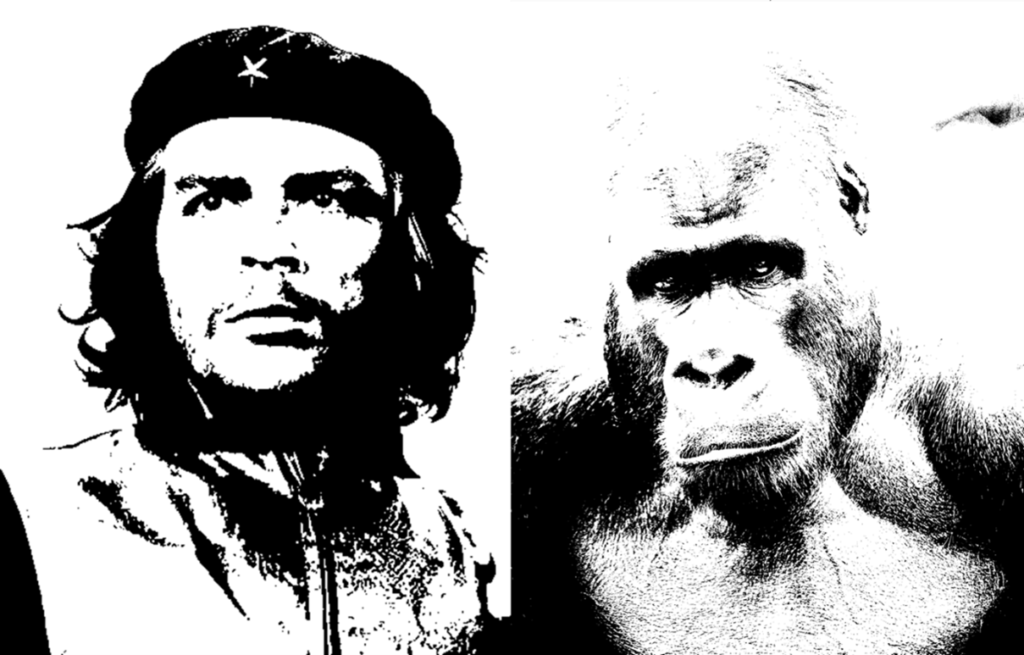We all know what a guerrilla is.
Definition:
A member of a small independent group taking part in irregular fighting, typically against large, regular forces.
Think Che Guevara.
And we all know what a gorilla is.
Definition:
A powerfully built great ape with a large head and short neck, found in the forests of central Africa. It is the largest living primate.
Think King Kong.
But smaller.
In a conversation about marketing, as in their dictionary definitions, while guerilla and gorilla may sound similar, it’s important to establish which type of marketing you’re talking about to avoid any raised eyebrows.
Similarly, in a conversation about overthrowing a despotic regime, it’s also important to be 100% clear on which spelling you’re referring to, if you want to avoid a potential car crash of a coup d’état.
But I digress.
OK, let’s start with the Gorilla approach to marketing – it’s about owning the jungle, owning the category, becoming so synonymous with it that it’s taken for granted – making it really difficult for anyone else to get to the top of the pile.
Think Coca-Cola.
Remember the joke?
Q. Where does a 500lb Silverback Gorilla sit?
A. Wherever it wants.
The reality is most brands aren’t Gorillas. There’s usually only room for a couple of them in any given sector of the jungle.
That’s why most brands are better off trying to be Guerillas than big fat Silverbacks.
And being a revolutionary is definitely way sexier than being an enormous ape. I should know.
Let’s go back to the definition of Guerrilla. IRREGULAR warfare. Unconventional.
Guerilla marketing relies on creativity, imagination and ingenuity rather than a massive marketing budget. It’s all about generating word of mouth, and then user-generated content. It’s about generating a disproportionately high return on investment.
Think about it.
Organise a flash mob, put on a performance in a crowded train station (at rush hour), gain hundreds or even thousands of mentions, likes and shares on social media… and the algorithms take it viral, reaching hundreds of thousands, or more.
Obviously, that’s an ideal scenario, but the point is that in conventional marketing, you’ll generally only reach the audience that you’ve paid to reach – the media owner is in charge. Yes, you can be really creative with your messaging and get better cut through if you do it well, but ultimately you have to pay to repeat your message over and over again. It’s how conventional advertising works.
With guerilla marketing, success isn’t dependent on big budgets, success comes from capturing people’s imaginations, catching them off-guard and creating something that people want to talk about and share. And it doesn’t have to be a huge showy event or stunt.
Remember The Blair Witch Project? In 1999 (relatively early in the history of the internet), this low budget horror movie became an international blockbuster by creating an actual urban legend surrounding the Blair Witch, and a story that made us believe (at least for a while) that this film was actual footage from a genuine amateur documentary team – thanks to a website that thousands of early adopters bought into, along with posters that helped to blur the line between fantasy and reality.
Low budget film. Low budget marketing. Disproportionately huge impact.
But guerrilla marketing isn’t just for brand with limited budgets. Coca-Cola is certainly not a brand that’s short of a few quid, but that doesn’t mean it can’t join in. Far from it.
The “Hug Me” Coke machine campaign featured a special vending machine that dispensed a free Coke when users hugged it. First launched in Singapore in 2012 and later expanded to other countries, including the US, Pakistan, and India, the campaign was a huge success, generating significant media attention and social media buzz – and winning the Cannes Lions Gold award in the PR category.
So where do we start?
One of the attractions of guerrilla marketing is that it can often feel spontaneous and a bit random – it’s good to see brands apparently kicking back and having fun. But like any form of marketing, successful guerrilla marketing takes careful planning.
Thinking like a guerrilla? Here are a few key steps to getting guerrilla-ready.
Set goals and objectives:
Define what you’re trying to achieve. Do you want to increase brand awareness or salience, generate leads, drive sales, or something else? Having clear goals and objectives will help you understand if you’re going in the right direction and measure the success of your campaign. But be single minded, and don’t pin your marketing success on it.
Identify your target audience:
Determine who your target audience is, where they live, work and socialise and what their needs and interests are. What do they enjoy doing, what sort of stuff are they sharing on social media? Think about how you want your campaign to resonate with them.
Develop the creative idea:
Guerrilla marketing is all about creativity and innovation. Breaking the mould. Brainstorm ideas that are unique, attention-grabbing, and relevant to your brand and target audience. No idea is a bad idea – build on it. Don’t be afraid to be different. Don’t be afraid to be provocative.
Set a budget & plan your execution:
Guerrilla marketing is typically low-cost, but you will still need to allocate adequate resources for materials, equipment, and promotion. Think about how to execute your idea, including what resources you’ll need to do it justice. Remember, guerrilla marketing is about creating impact for a return that’s far greater than the cost – don’t go into it half-arsed and lose that impact. But at the same time, by definition you’ll be doing something new; you can’t guarantee success so don’t bet the entire budget either.
Measure and evaluate:
Track and analyze the results of your campaign to see how well it performed and what you can learn for future campaigns. Much easier to assess if you’ve set yourself clear objectives in the first place.
And finally:
Whilst guerrilla marketing is about being unconventional, you should always remain legal, ethical, and try not to offend (within reason). With careful planning, creativity, and execution, relatively small scale guerrilla marketing campaigns can have a big, big impact on brand awareness and engagement.
And remember, even if you’re a big fat gorilla, you can still be guerrilla.




